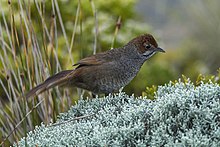bristlebird
Appearance
English
[edit]
Etymology
[edit]Noun
[edit]bristlebird (plural bristlebirds)
- Any of three species of passerine birds in the genus Dasyornis endemic to Australia.
- 2002, Bernhard Grzimek, Michael Hutchins, Grzimek's Animal Life Encyclopedia, volume 11, page 57:
- The bristlebirds have suffered from habitat loss, increased fire frequency, grazing by introduced mammals, and predation by mammalian carnivores.
- 2012, Lee K. Curtis, Andrew J. Dennis, Keith R. McDonald, Peter M. Kyne, Stephen J. S. Debus, editors, Queensland's Threatened Animals, page 315:
- A pilot captive-breeding program at the David Fleay Wildlife Park (DERM) on the Gold Coast has successfully bred Eastern Bristlebirds, with 13 birds raised over four years.
- 2014, David KeithDavid Lindenmayeret al., “7: Heathlands”, in Emma Burns, David Lindenmayer, Andrew Lowe, Nicole Thurgate, editors, Biodiversity and Environmental Change: Monitoring, Challenges and Direction, page 244:
- The Eastern Bristlebird (Dasyornis brachypterus) (Fig. 7.28) is an endangered species that has disappeared from large parts of its range in heathland environments throughout eastern Australia. A significant population of the Eastern Bristlebird remains at Booderee National Park and has received considerable study (Pyke et al. 1995; Baker 1997, 2000).
Derived terms
[edit]- eastern bristlebird (Dasyornis brachypterus)
- rufous bristlebird (Dasyornis broadbenti)
- western bristlebird (Dasyornis longirostris)
Further reading
[edit] bristlebird on Wikipedia.Wikipedia
bristlebird on Wikipedia.Wikipedia  Dasyornithidae on Wikispecies.Wikispecies
Dasyornithidae on Wikispecies.Wikispecies  Category:Dasyornis on Wikimedia Commons.Wikimedia Commons
Category:Dasyornis on Wikimedia Commons.Wikimedia Commons
